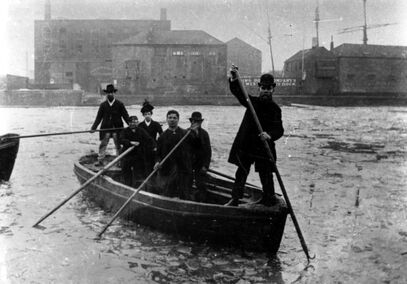
Gas Ferry in the ice, 20 January 1891Gas Ferry in action in the frozen Harbour nearing the gas works, looking towards Great Western shipyard.

Rownham Ferry at low tide, about 1900.
Rownham ferry in action at low tide, acting as a pontoon bridge. Note passenger approaching with milk churns on yoke.

Rownham ferry at work at low tide, about 1890.

The ferry at Pill seen from the Shirehampton bank, about 1940s.

Mardyke ferry "Brandon" with HMS "Flying Fox", Royal Navy Volunteer Reserve HQ, on the Hotwells side. 14th February 1961.

An engraving showing the paddle steamer Beaufort passing the New Inn with the Rownham ferry boat to its right in about 1830
For many years, the best way to cross the tidal River Avon was by a series of ferries. The furthest downstream was at Pill, crossing to the Lamplighters Inn on the Gloucestershire bank, until it closed in 1973. Bridges have now replaced many of these.
In 1528 Thomas Alye claimed the right to operate a ferry at Rownham in competition with the long-established one run by the abbot of St Augustines. Alye undercut the abbot's prices in an effort to get the business, charging 1/4d (0.10p) for foot passengers and 1/2d (0.25p) for riders and their horses. The abbot took decisive action to stop this, sending his servants to seize the rival boat. Alye took his case to the Court of Star Chamber, where the circumstances of the seizure were debated; Alye claimed that the seizure had been carried out in a violent and riotous manner, whilst the abbot denied this. It appears that the abbot won the case, as the ferry remained in his hands, and later passed to the Dean and Chapter of the Cathedral. The fact that he was prepared to take such decisive action illustrates the importance of the ferry at the time.
Rownham ferry continued to operate until 1932, having been moved slightly upstream from its traditional location when new entrance locks for the Harbour were built in the 1870s.